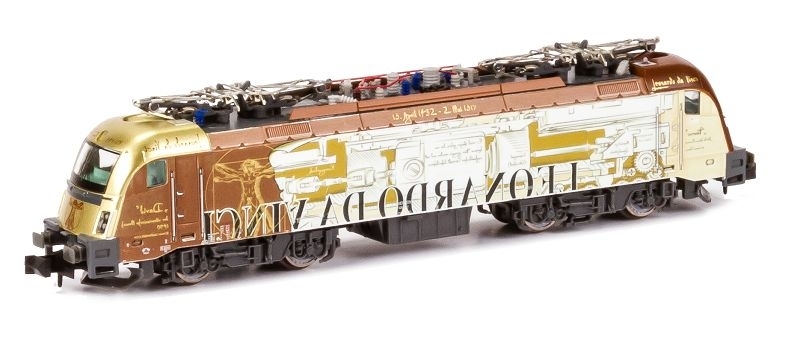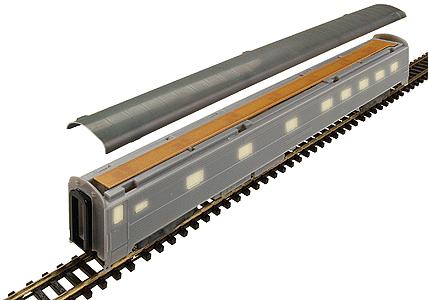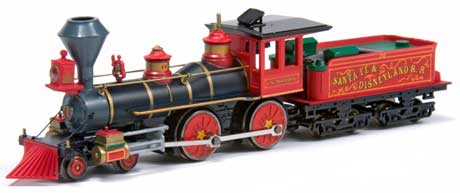Model Information: Neodymium motor with flywheel powers all 4 axles. One axle with 2 traction tires. LED light change from white to red with direction. NEM coupler pocket. Locomotive can be switched between rail and catenary power.
Prototype History: Based on the Siemens Eurosprinter concept, the ES 64 U was developed as a universal electric locomotive with a top speed of 230 km/h (140 mph). The ÖBB assigned the protected name Taurus to Class 1016 (and later to the Classes 1116 and 1216); since then all ES 64 U+ series are widely known as 'Taurus' locos.
The locomotives of this type are multi-system electric locomotives of the latest generation, which can be used for heavy freight traffic and the fast travel across borders. They currently operate in Austria, Bulgaria, Croatia, Czech republic, Germany, Italy, Hungary, Poland, Romania, Slovakia, Slovenia and Switzerland.
They have been produced in three different variants:
U64U - ÖBB BR 1016 - only operating on 15 kV 16 2/3 Hz AC supply in Austria.
Built: 1999–2006 - more than 300 produced for ÖBB (combined with BR 1116)
U64U2 - ÖBB BR 1116 - can also operate on 25 kV 50 Hz AC.
- also referred to as (Germany) Deutsche Bahn AG Class 182, (Hungary) MÁV Class 470, GySEV Class 1047
Built: 1999–2006 - more than 300 produced for ÖBB (combined with BR 1016)
U64U4 - ÖBB BR 1216 - can operate under 4 different 3-phase supplies.
- also referred to as (Slovenia) Slovenske železnice (SŽ) Class 541, (Poland) PKP Intercity (PKP IC) Class EU44 "Husarz", (Italy) FS E 190.
Built: 2005–2011 - initial order of 50 by ÖBB
On 2 September 2006 the locomotive 1216 025-7 (prior to delivery to ÖBB) set a new world record for conventional electric locomotives, when, during the trials near Nürnberg, it reached a top speed of 357 km/h (222 mph).
The locomotive was not modified for the record. Since then, this type has become the fastest locomotive in the world.
From Wikipedia
Read more (in German) about ES64U2 and ES64U4
The locomotives of this type are multi-system electric locomotives of the latest generation, which can be used for heavy freight traffic and the fast travel across borders. They currently operate in Austria, Bulgaria, Croatia, Czech republic, Germany, Italy, Hungary, Poland, Romania, Slovakia, Slovenia and Switzerland.
They have been produced in three different variants:
U64U - ÖBB BR 1016 - only operating on 15 kV 16 2/3 Hz AC supply in Austria.
Built: 1999–2006 - more than 300 produced for ÖBB (combined with BR 1116)
U64U2 - ÖBB BR 1116 - can also operate on 25 kV 50 Hz AC.
- also referred to as (Germany) Deutsche Bahn AG Class 182, (Hungary) MÁV Class 470, GySEV Class 1047
Built: 1999–2006 - more than 300 produced for ÖBB (combined with BR 1016)
U64U4 - ÖBB BR 1216 - can operate under 4 different 3-phase supplies.
- also referred to as (Slovenia) Slovenske železnice (SŽ) Class 541, (Poland) PKP Intercity (PKP IC) Class EU44 "Husarz", (Italy) FS E 190.
Built: 2005–2011 - initial order of 50 by ÖBB
On 2 September 2006 the locomotive 1216 025-7 (prior to delivery to ÖBB) set a new world record for conventional electric locomotives, when, during the trials near Nürnberg, it reached a top speed of 357 km/h (222 mph).
The locomotive was not modified for the record. Since then, this type has become the fastest locomotive in the world.
From Wikipedia
Read more (in German) about ES64U2 and ES64U4
Road Name History:  The Austrian Federal Railways (German: Österreichische Bundesbahnen or ÖBB, formerly the Bundesbahn Österreich or BBÖ) is the national railway system of Austria, and the administrator of Liechtenstein's railways. The ÖBB group is owned entirely by the Republic of Austria and is divided into several separate businesses that manage the infrastructure and operate passenger and freight services.
The Austrian Federal Railways (German: Österreichische Bundesbahnen or ÖBB, formerly the Bundesbahn Österreich or BBÖ) is the national railway system of Austria, and the administrator of Liechtenstein's railways. The ÖBB group is owned entirely by the Republic of Austria and is divided into several separate businesses that manage the infrastructure and operate passenger and freight services.
The Austrian Federal Railways has had two discrete periods of existence. It was first formed in 1923, using the Bundesbahn Österreich name, as a successor to the Imperial Royal Austrian State Railways (kkStB), but was incorporated into the Deutsche Reichsbahn during the 1938-1945 Anschluss. It was reformed in 1947, using the slightly different Österreichische Bundesbahnen name, and remains in existence in this form.
Major changes currently being made to the Austrian railway network are the construction of the Wien Hauptbahnhof (Vienna main station), the Koralm Railway, the Semmering Base Tunnel and the Brenner Base Tunnel connection with Italy.
From Wikipedia

The Austrian Federal Railways has had two discrete periods of existence. It was first formed in 1923, using the Bundesbahn Österreich name, as a successor to the Imperial Royal Austrian State Railways (kkStB), but was incorporated into the Deutsche Reichsbahn during the 1938-1945 Anschluss. It was reformed in 1947, using the slightly different Österreichische Bundesbahnen name, and remains in existence in this form.
Major changes currently being made to the Austrian railway network are the construction of the Wien Hauptbahnhof (Vienna main station), the Koralm Railway, the Semmering Base Tunnel and the Brenner Base Tunnel connection with Italy.
From Wikipedia
Item created by: gdm on 2016-12-11 10:53:22. Last edited by Alain LM on 2021-03-24 05:53:19
If you see errors or missing data in this entry, please feel free to log in and edit it. Anyone with a Gmail account can log in instantly.
If you see errors or missing data in this entry, please feel free to log in and edit it. Anyone with a Gmail account can log in instantly.










